LUFTWAFFE KICKS OFF EAGLE DAY OVER BRITAIN
London, England • August 13, 1940
Although the Battle of Britain (July 10 to October 31, 1940) had intensified days earlier, the Luftwaffe’s air attacks had been launched in poor weather and were mostly limited to the south of England. However, on this date, August 13, 1940, a Tuesday, the Luftwaffe sent five waves of fighters, dive bombers, and bombers, over 1,485 sorties in all, from bases in occupied France, Belgium, Norway, and Denmark to bomb airfields and airfield installations from England’s southwest to northeast. Radar stations all along the English coast could not help but pick up the huge formations heading toward England. Radar screens were overwhelmed by so many enemy aircraft crossing the Channel on Adlertag (“Eagle Day”) that the different formations could not even be distinguished. Luftwaffe chief Hermann Goering told his pilots: “Within a short period you will wipe the British air force from the sky.”
The onslaught of German fighter planes and bombers was intended to entice every one of Britain’s Spitfire and Hurricane fighter squadrons into the air where they could be destroyed in dogfights or destroyed on airfields. Besides killing several hundred civilians, German planes severed main power supply lines; demolished buildings, storage sheds, hangers, 47 aircraft on the ground and 13 in the air; rendered several airfields unserviceable for days; and destroyed one radar tower and damaged four others for a loss of 39 aircraft. Three days into Operation Eagle Attack (Unternehmen Adlerangriff) Goering’s Luftwaffe officially lost an additional 76 aircraft and 148 crewmen, a sunny day German aircrews dubbed “Black Thursday” (Schwarzer Donnerstag) and the British “The Greatest Day.” In the first week of September the Luftwaffe lost over 125 aircraft, and in a mid-September raid over London the Luftwaffe lost 55 more. All told, between July and the end of October 1940 the Luftwaffe lost approximately 1,686 aircraft to the Royal Air Force’s 1,643 (sources vary on both sides), making the long, strung-out air campaign nearly a draw in the number of planes downed.
British air supremacy over their own island and the Luftwaffe’s faulty intelligence about RAF resources (for example, RAF Fighter Command’s 18 Chain Home radar and control stations, which covered most of the south and east coasts of England and provided information essential to intercepting incoming German aircraft), combined with Adolf Hitler’s decision to husband his air resources for the 1941 Nazi assault on the Soviet Union (Operation Barbarossa), allowed Britain to soldier on alone until joined by the U.S. in early December 1941. The Luftwaffe’s failure to destroy British air defenses or force Britain to negotiate an armistice or an outright surrender is considered Germany’s first major defeat and a crucial turning point in World War II. Speaking before the House of Commons on August 20, 1940, Prime Minister Winston Churchill famously repeated what he had said five days earlier: “Never in the field of human conflict was so much owed by so many to so few.”
![]()
British and German Aircraft During the Battle of Britain, July to October 1940
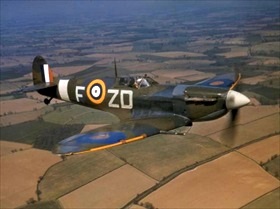 | 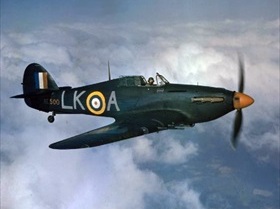 |
Left: The Supermarine Spitfire was a British single-seat, short-range, high-performance interceptor aircraft. It was powered by a 1,000‑horsepower Rolls Royce Merlin V‑12 piston engine with a float-controlled carburetor using American-supplied 100‑octane aviation fuel. (The Germans used a lower grade 87‑octane fuel and fuel-injected engines.) The Spitfire was perceived by the public as the RAF fighter during the airborne Battle of Britain. Spitfire units had a lower attrition rate and a higher victory-to-loss ratio than pilots flying Hawker Hurricanes, though the more numerous Hurricanes shouldered a greater proportion of the burden against the Luftwaffe. More than 20,350 Spitfires were built between 1938 and 1948.
![]()
Right: The Hawker Hurricane was a British single-seat fighter aircraft. Much of the Hurricane was covered with fabric rather than metal, making it easier to build and easier for ground crews to repair. Enemy cannon fire, for instance, would pass cleanly through the craft, often without causing the extensive damage suffered by the all-metal Spitfire. Overshadowed by the Spitfire, the Hurricane became renowned during the Battle of Britain, accounting for 60 percent of the RAF’s air victories in the battle. Generally, Spitfires would intercept cannon-equipped German fighter aircraft, leaving Hurricanes to concentrate on destroying slower-moving German bombers. Over 14,500 Hurricanes were built between 1937 and 1944.
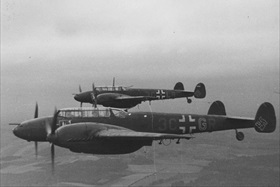 | 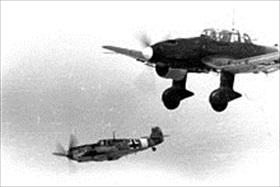 |
Left: The Messerschmitt Bf 110 was a slow-moving German twin-engine, two-seater heavy fighter. Its lack of agility in the air was exposed during the Battle of Britain, when some Bf 110-equipped units were withdrawn from the battle after very heavy losses and redeployed as night fighters (like the three-seater version shown in this photo from June 21, 1942, over occupied France), a role to which the aircraft was well suited. Close to 6,200 Bf 110s were built.
![]()
Right: A German Junkers Ju 87 B two-man dive bomber and ground attack aircraft (foreground) and the single-seater Messerschmitt Bf 109 E, January 1941. The most distinctive airplane of the early war on account of its large propeller, inverted gull wings, fixed landing gear, and intimidating sirens (“Jericho Trumpets”) in a dive (as steep as 90 degrees at 350 mph), the Ju 87, or Stuka (short for Sturzkampfflugzeug), carried a pilot and a radio operator with a rear-facing gun. The Stuka’s flaws became apparent during the Battle of Britain and they were withdrawn from the fight. Poor maneuverability and a lack of both defensive armament and speed (maximum 200–240 mph) meant that Stukas required heavy fighter escort to operate effectively. They typically carried a single 551‑lb bomb under the fuselage and four 100‑lb bombs under the wings. An estimated 6,500 Ju 87s were built by Germany. The archaic but durable “little bomber,” as the Luftwaffe called it, had the distinction of dropping the first bombs of World War II in Europe on September 1, 1939, scoring the first air-to-air kill, and sinking most of the Polish navy. Over 400 Stukas served as “flying artillery” in the Battle of France and the Low Countries, notoriously strafing columns of refugees. Stukas flew the final Luftwaffe ground-assault mission on May 4, 1945. Single-seat Bf 109s (like the one seen in the background) were the backbone of the Luftwaffe’s fighter force, serving famously during the Battle of Britain as bomber escorts; fighter-bombers; day-, night-, and all-weather fighters; and ground-attack aircraft. The Bf 109 was the most-produced fighter aircraft in history, with a total of 33,984 units produced between 1936 and April 1945.
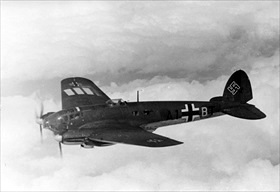 | 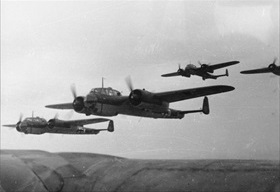 |
Left: A German Heinkel He 111 over Belgium or France, September 1940. The He 111 was a fast medium bomber. It was the most numerous and the primary Luftwaffe bomber during the early war years. It was used as a strategic bomber during the Battle of Britain and up until then fared well, when its weak defensive armament, relatively low speed, and poor maneuverability were exposed. Roughly 6,500 He 111s were built between 1935 and 1944.
![]()
Right: Along with the Heinkel He 111, the German Dornier Do 17, sometimes called the “flying pencil,” was the main bomber type of the Luftwaffe in 1939–1940. It was popular among its crews owing to its maneuverability at low altitude, but its effectiveness and usage was curtailed by its limited bomb load and range. Just over 2,100 Do 17s were built between 1934 and 1940.
Churchill’s Speech to Parliament, August 20, 1940: “Never in the field of human conflict . . .”
![]()

 History buffs, there is good news! The Daily Chronicles of World War II is now available as an ebook for $4.99 on Amazon.com. Containing a year’s worth of dated entries from this website, the ebook brings the story of this tumultuous era to life in a compelling, authoritative, and succinct manner. Featuring inventive navigation aids, the ebook enables readers to instantly move forward or backward by month and date to different dated entries. Simple and elegant! Click
History buffs, there is good news! The Daily Chronicles of World War II is now available as an ebook for $4.99 on Amazon.com. Containing a year’s worth of dated entries from this website, the ebook brings the story of this tumultuous era to life in a compelling, authoritative, and succinct manner. Featuring inventive navigation aids, the ebook enables readers to instantly move forward or backward by month and date to different dated entries. Simple and elegant! Click 











